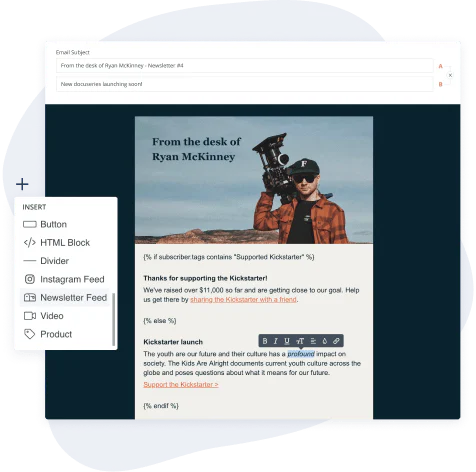In this Article
Create an opt-in form or a landing page. Promote it to an audience. Win new email subscribers and then make them wait for your next newsletter edition.
That last part doesn’t quite make sense, right?
As creators, we work hard to attract new subscribers with content, our personalities, and value. But once they’re on our email list, it’s easy to neglect that delicate period when they’re pumped to dive right in and learn from us.
The bridge during that period? Welcome emails and sequences.
Creators like you are crediting the success of their email strategy to their welcome emails. But welcome emails can be intimidating to write.
In this guide, we’re diving into examples from creators, welcome email templates you can swipe, and tips to make them your own.
What is a welcome email?
A welcome email is the first email a new subscriber receives from you after signing up for your email list. A welcome email is your chance to make a strong first impression on new subscribers, give them value, and make them excited about this new journey they’ve just started.
Great welcome emails are more than just a generic “Thank you for signing up!” note. It’s a chance to introduce yourself and set your subscriber’s expectations about the frequency, quality, and topics of your upcoming emails and content.
And not just that.
Welcome emails tend to have the highest open rates compared to other types of emails.
Some data shows welcome email open rates can be as high as 91%, compared to the average email open rate of 43% for Kit creators or a 21.5% open rate across industries.

Why are welcome email sequences important?
Here’s what makes welcome emails an essential building block in your email strategy and your business strategy as a creator:
- Fresh subscribers are excited to hear from you: New email subscribers are excited about the promise you made on your landing page or your signup form, like a freebie you promised. It’s the perfect time to deliver more than what they’ve expected. Welcome emails are the ideal format to introduce yourself, your work, and how they can benefit from it.
- Lead all subscriber types along the same path: If you’ve implemented different ideas to grow your email list, it means subscribers can end up on your list with very different contexts—some after following you for years, other after a minute of Google searching. A welcome email is a chance to bring them all to the same level of knowing you by sharing your story, background, goals, and best content.
- Turn one-way emails into dialogues: Emails take your audience from noisy social media feeds to individually curated inboxes. Whether it goes out to 15 people or 15,000, an email feels personal. This makes welcome emails an excellent opportunity to ask questions and encourage replies.
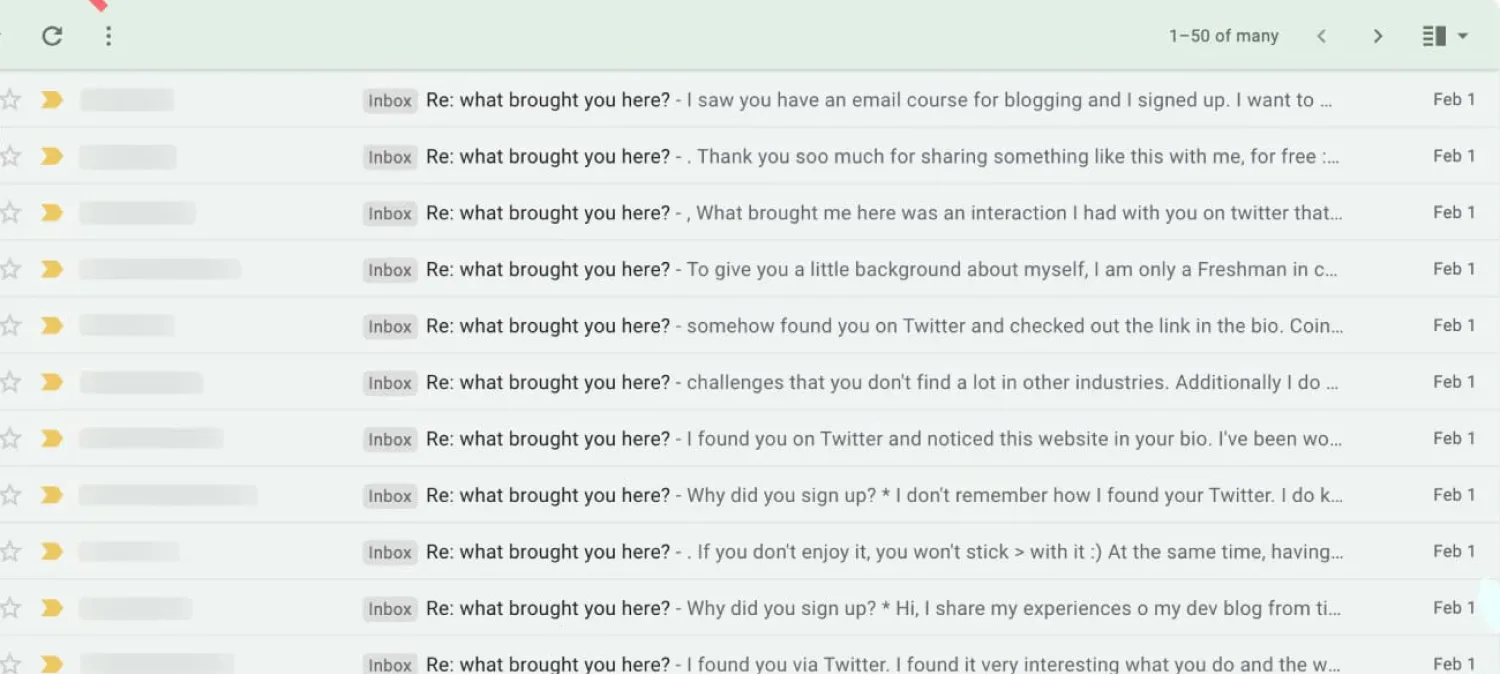
Monica Lent, the creator behind the Blogging for Devs newsletter and community, saw a 25% response rate to her welcome email in the first few weeks of launching her free 7-day course. Image via Monica’s case study with Kit.
The blocks that make up the anatomy of welcome emails
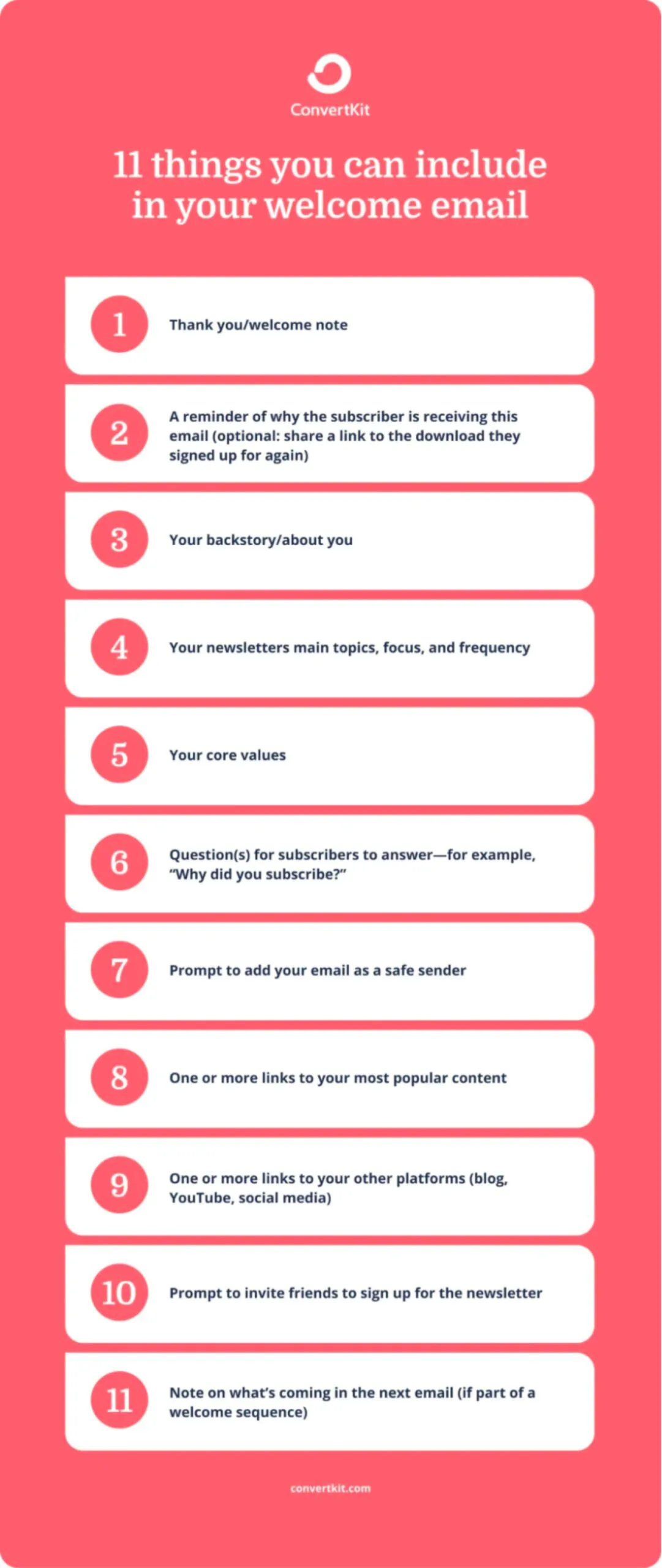
Want to see what some of the best welcome emails look like? We combed our inboxes to find the below 10 welcome email examples from creators just like you and dissected them into building blocks.
Here are the blocks that make up the anatomy of a welcome email:
- A thank you and/or welcome note: 1-2 sentences that show your gratitude and joy for having this new subscriber join you
- A reminder of why they joined: a brief summary of the signup page they came through or a lead magnet they downloaded (you can even share the link to the download again)
- Your backstory: details about you and why you’re the right person to trust on this topic
- Expectation setting: the main topics, focus, and frequency of your emails
- Your core values: what you stand for as a creator and what drives your work
- Question(s) for subscribers: asking why they subscribed and their main challenges to prompt replies to your emails and to learn more about who you serve
- Safe-listing ask: prompt your new subscribers to add your email as a safe sender
- Content promotion: one or more links to your most popular content
- Platform promotion: one or more links to your other platforms (blog, YouTube, social media)
- Friend invite prompt: encourage subscribers to invite friends to sign up for your newsletter
- Note about next email: information on when they’ll receive the next email from you (like the next one in the welcome email sequence or the next regular newsletter)
You’ll see different orders and combos of these blocks in the following examples.
Dissecting 10 welcome email examples for new subscribers
Check out these real-life welcome email examples that new subscribers can’t resist. Use them to get inspired for your email subject lines, style of your welcome message, or email structure:
1. Anne-Laure Le Cunff: Maker Mind’s welcome email
Anne-Laure Le Cunff is an entrepreneur and neuroscience student. She runs Ness Labs, a learning platform for knowledge workers who want to do their best work without burning out. It offers a range of resources like a private community, online courses, and workshops.
Part of Ness Labs is the Maker Mind newsletter. When you sign up for the newsletter, here’s the email that welcomes you:
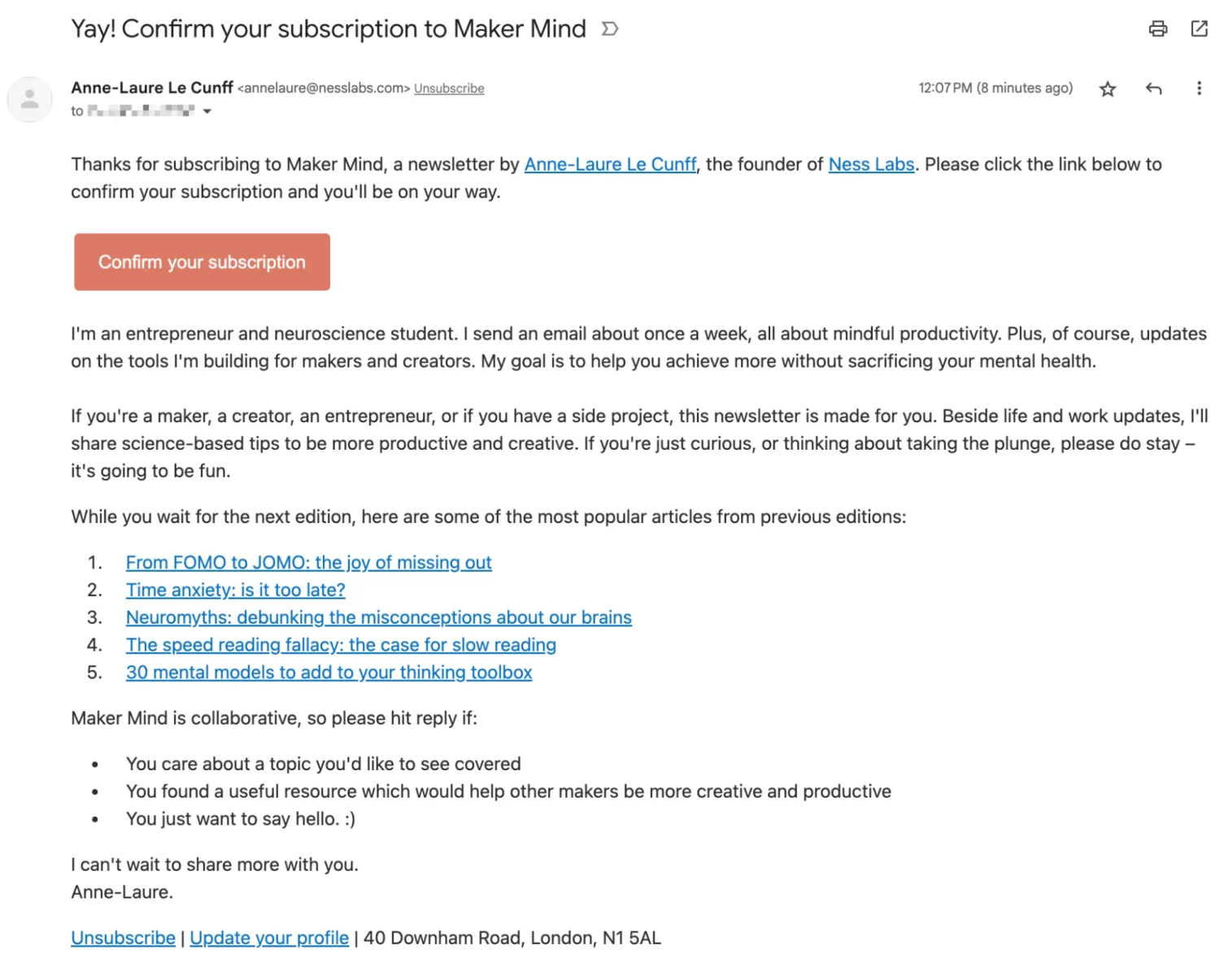
The Maker Mind welcome email
Welcome email subject line: Yay! Confirm your subscription to Maker Mind
This subject line is fantastic because it conveys excitement for what’s to come, asks the subscriber to confirm the subscription inside, and reinforces the name of the newsletter—all in just a few words.
It stands out from the usual ‘confirm your subscription’ emails that easily get missed in a busy inbox.
Welcome email structure:
- A thank you note
- Subscription confirmation button
- Introduction to Anne-Laure and her goals
- The newsletter focus and frequency
- A list of five popular articles on the blog
- A prompt to reply to the email with topic suggestions and feedback
Check out how Anne-Laure ditched the Silicon Valley formula to start a thriving newsletter.
2. Monica Lent: Blogging For Devs’ welcome email
Monica Lent is the creator behind Blogging For Devs, a newsletter and a private community for developers, indie hackers, and tech creators who want to grow their audience by writing online.
Monica offers a free, 7-day email course to incentivize people to join the Blogging For Devs newsletter. But before the first email of the free email course, new subscribers get this welcome email:
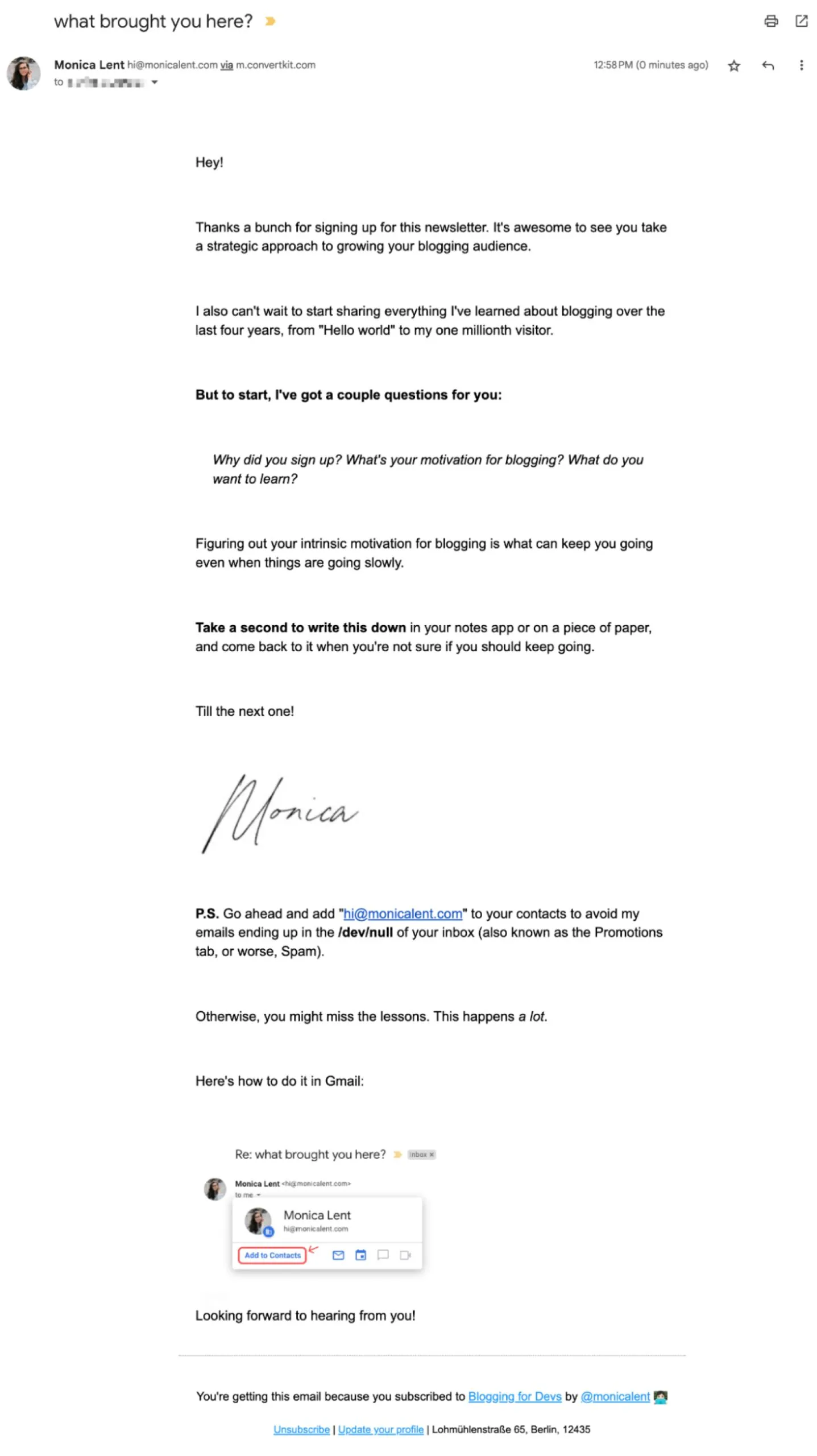
The Blogging For Devs welcome email
Welcome email subject line: what brought you here?
This is an effective subject line because it instantly focuses on the subscriber. It’s not about what Blogging For Devs is about—although the email touches upon that, too—but about the motivations and needs that led this person to sign up in the first place.
Welcome email structure:
- A thank you note
- The general topics for the newsletter
- Questions: “Why did you sign up? What’s your motivation for blogging?” and a tip on using that as intrinsic motivation to keep going
- A prompt to list Monica as a safe sender
Check out how Monica built a thriving paid community for developers.
3. Amanda Goetz: Life’s a Game’s welcome email
Amanda Goetz is the founder of multiple brands, a seasoned marketer, and a single mom of three kids.
Her content is focused on personal and professional growth, and her weekly newsletter Life’s a Game follows suit. It’s for ambitious people like founders, leaders, and builders who want to live without sacrifice or burnout. In it, Amanda covers topics like personal growth, productivity, career growth, mental health, money, and relationships.

The Life’s a Game welcome email
Welcome email subject line: 🧩 Welcome to Life’s a Game with Amanda Goetz
Even though the “Welcome to…” structure can feel quite generic, when you pair it with unique elements like emojis and the newsletter name, it stands a huge chance to stand out.
Not just that: if your welcome message is valuable, with useful links and actionable tips, subscribers may want to come back to it time and time again—and this makes it easy to spot in a busy inbox.
Welcome email structure:
- A welcome note
- Introduction to Amanda and her goals with the newsletter
- Newsletter frequency
- A prompt to reply to her email
- Links to previous newsletter editions
- A P.S. with a note about subject line emoji, a link to submit a mailing address for surprises, and social media links
4. Daren Smith: Craftsman Creative’s welcome email
Daren Smith is a film producer and the creator behind Craftsman Creative, where he teaches systems and principles that help creative entrepreneurs grow their business.
His newsletter is aimed at creators who want to build six- and seven-figure companies by doing what they love, and he kicks it off with a free five-day email course—a welcome sequence of sorts.
Here’s the first email subscribers get, outlining what Daren is about and what’s to come:

The Craftsman Creative welcome email
Welcome email subject line: [Craftsman Creative] – You’re In! Here’s what’s next…
This is the trifecta of an effective welcome message subject line. It reinforces the newsletter name, the excitement for joining, and the value of the email in announcing what’s coming next.
Welcome email structure:
- Introduction of Daren and his focus as a creator
- The plan for upcoming emails in the welcome series and their goal
- A prompt to list Daren as a safe sender
- Email subject line structure for upcoming emails and newsletter
- A prompt to reply to his email
- Links to his blog and X/Twitter
Check out how Daren grew his $85,000+ business with under 10 hours per week with Kit.
5. Marie Poulin: Notion Mastery’s welcome email
Marie Poulin is a Notion pro who teaches digital business owners to design, streamline, optimize, and automate their business and life systems. She does so through her YouTube channel, Notion Mastery course, premium and free Notion templates—and, of course, her newsletter.
She’s a well-known name in this space, and her welcome message offers quite some nuance to how she approaches workflows, organization, and flexibility in project management:
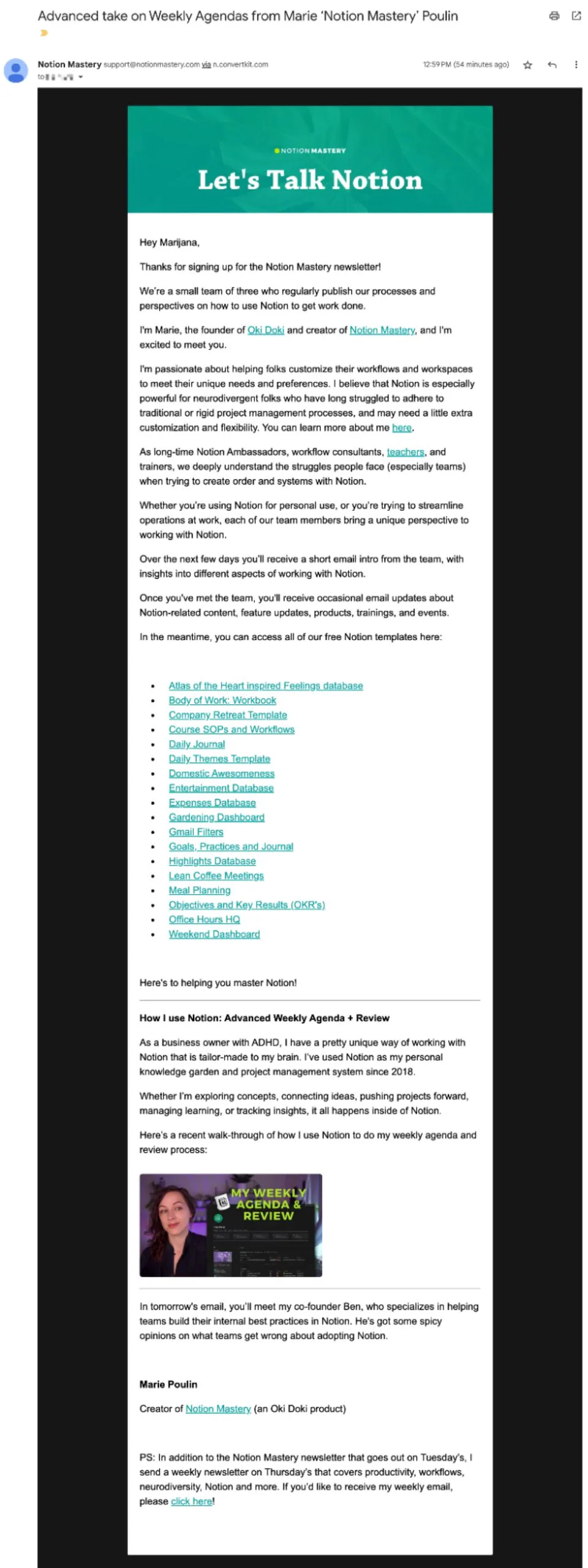
The Notion Mastery welcome email
Welcome email subject line: Advanced take on Weekly Agendas from Marie ‘Notion Mastery’ Poulin
The advanced take Marie mentions in this subject line relates to the video she shares toward the end of the welcome email. It’s Marie’s way of showing how she uses Notion in her personal life without getting too technical in the email itself.
Welcome email structure:
- A thank you note
- An introduction to Marie and what she and her team are passionate about when it comes to organization with Notion
- A note on what’s coming in the welcome series and beyond
- Links to all of Marie’s free Notion templates
- A block dedicated to the advanced weekly agenda process Marie uses
- A note about the next email
- A P.S. about additional weekly emails subscribers can sign up for
Check out how Marie uses Kit to manage her $40K/month course business.
6. Tiago Forte: Forte Labs’ welcome email
Tiago Forte is the creator behind Forte Labs. Forte Labs is a content platform for people who want a better way to learn, solve problems, and do their best work but often feel overwhelmed by the amount of information and ideas that would help them get there.
His course and books focus on building a second brain, a method of organizing a digital life.
Here’s how he kicks off each new newsletter subscriber’s journey:
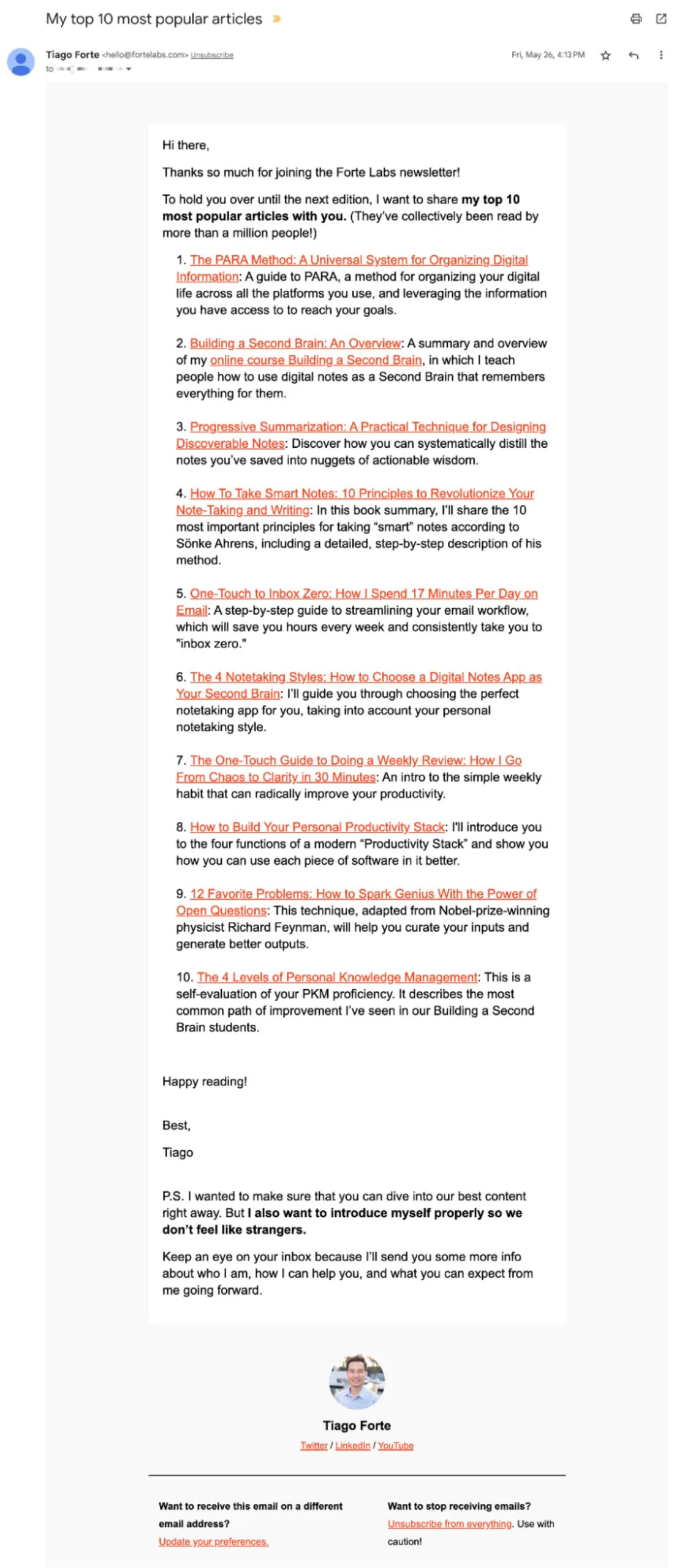
The Forte Labs welcome email
Welcome email subject line: My top 10 most popular articles
Tiago gives new subscribers his best articles right off the bat. He makes sure he doesn’t bury this value under the “Welcome!” subject line and goes right to the point, both in the subject line and the email itself.
Welcome email structure:
- A thank you note
- Links to the 10 most popular articles on the blog
- A P.S. that introduces the upcoming emails in the welcome sequence
7. Stacie Vaughan: Simply Stacie’s welcome email
Simply Stacie is a food blog focusing on easy and delicious recipes that anyone can cook. Stacie Vaughan launched Simply Stacie in 2008 to help others save time and money while cooking recipes that the whole family wants to enjoy.
Stacie builds her email list by offering a collection of her best recipes in an easy-to-use PDF to those who subscribe. Here’s the email she welcomes new subscribers with:
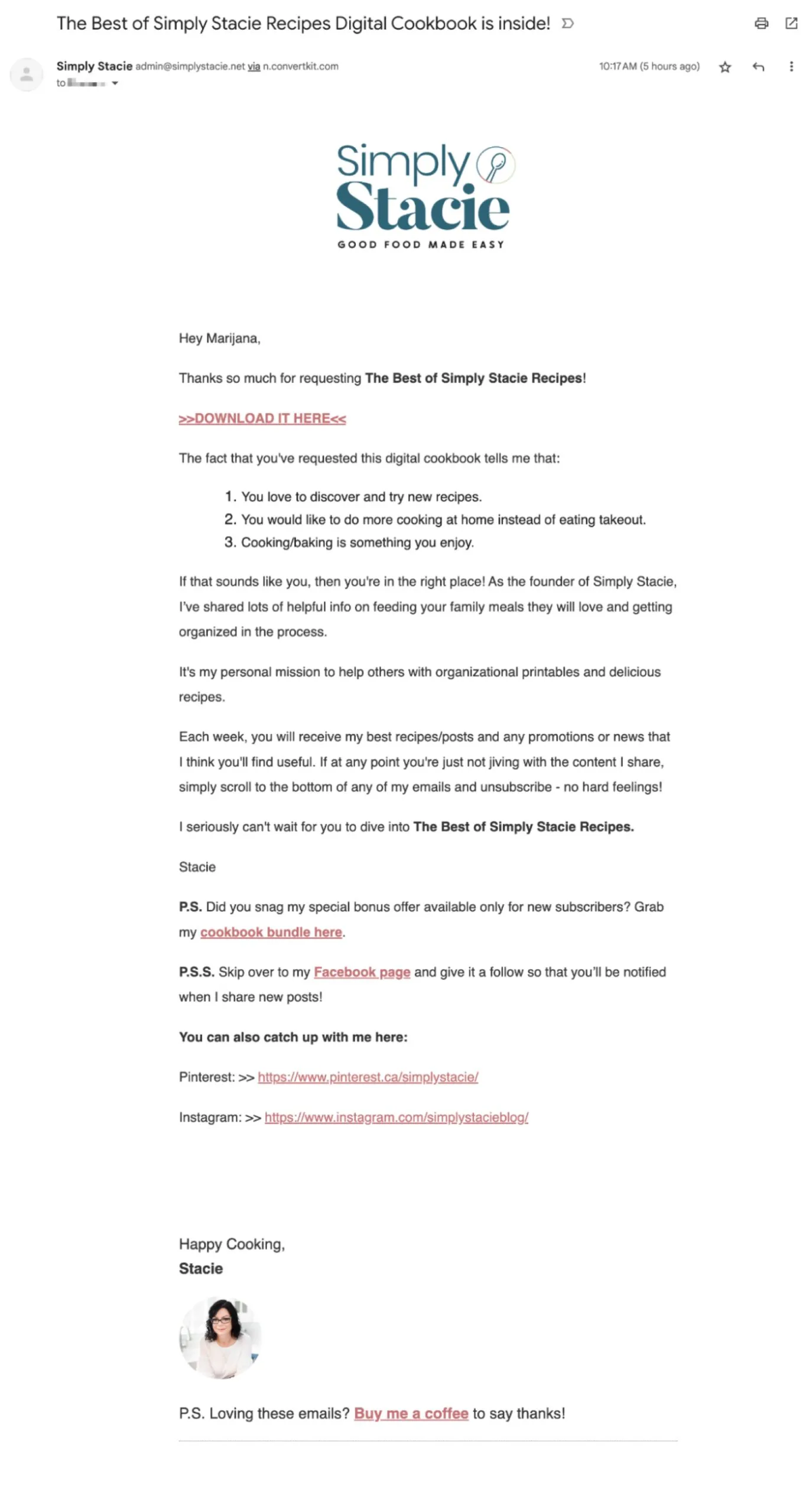
The Simply Stacie welcome email
Welcome email subject line: The Best of Simply Stacie Recipes Digital Cookbook is inside!
Stacie’s subject line focuses on the lead magnet the subscriber joined for in the first place. The email itself definitely offers a lot more than that, but she makes sure this freebie is easy to spot in a crowded inbox.
Welcome email structure:
- A thank you note
- Link to the freebie
- Introduction of the Simply Stacie blog
- A note on what’s to come in future emails
- A P.S. note with a discounted product bundle for new subscribers
- Links to social media platforms
- A link to Stacie’s digital tip jar page
8. Khe Hy: RadReads’ welcome email
Khe Hy is the founder of RadReads, a newsletter and blog about living an intentional life. He teaches the Supercharge Your Productivity, a course that merges the power of Notion with the skill of being intentional with managing and planning work and life. Khe’s newsletter reaches more than 50,000 people every week.
Before getting the first weekly newsletter, each subscriber first receives this welcome email from Khe:

The RadReads welcome email
Welcome email subject line: Hey, what’s up?
This subject line is what you’d expect from an email a friend or your favorite colleague would send you. It matches the tone and focus of Khe’s welcome message—the longest welcome email scroll on our list—and his emails in general.
Welcome email structure:
- A message of gratitude
- A narrative-based email body about what RadReads stands for: a productive, examined and joyful life
- A prompt to reply to Khe’s email
- A P.S. with a link to a 23-minute mini-documentary about Khe’s background and story
Check out how Khe maintains a +50% open rate with his tens of thousands of subscribers.
9. Danielle Canty: The Two Percent’s welcome email
Danielle Canty was a chiropractor in her past career. Now, she coaches female business owners as the co-founder of BossBabe and the creator behind her newsletter, The Two Percent.
Here’s her welcome message to new subscribers:
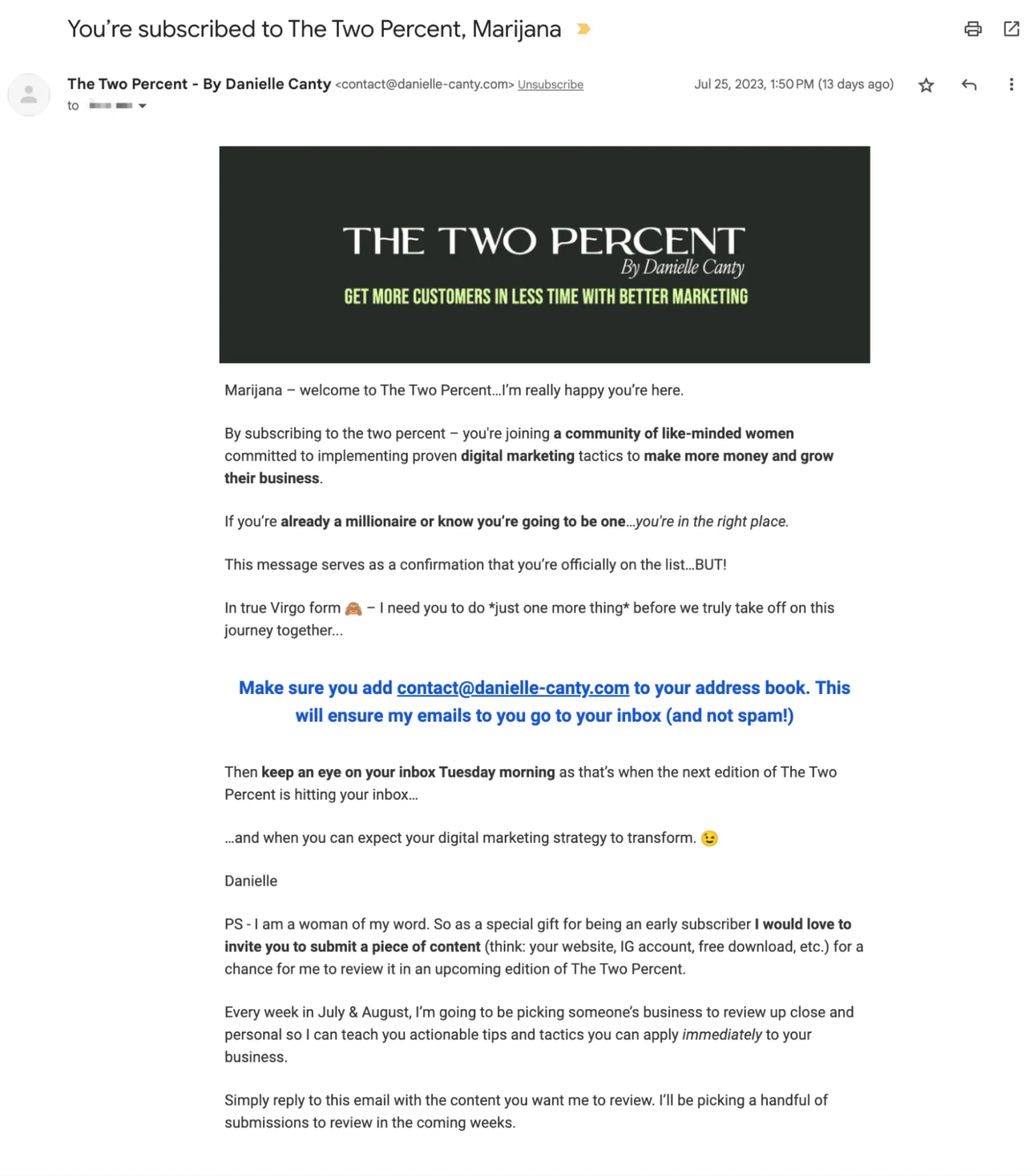
The Two Percent welcome email
Welcome email subject line: You’re subscribed to The Two Percent, Marijana
This email subject line goes straight to the point by confirming subscription. It also delights with first name personalization.
Welcome email structure:
- Short note about the goals of the newsletter
- A prompt to list Danielle as a safe sender
- A note on when the next newsletter edition is coming
- A P.S. note prompting subscribers to reply and submit a piece of content for a chance of review
10. Maurizio Leo: The Perfect Loaf’s welcome email
Maurizio Leo is an author and a software-engineer-turned-baker who created the website The Perfect Loaf. It’s an award-winning blog dedicated to baking sourdough bread at home, covering recipes, how-to guides, tools, and baking techniques.
Here’s how he welcomes new joiners to The Perfect Loaf online world:
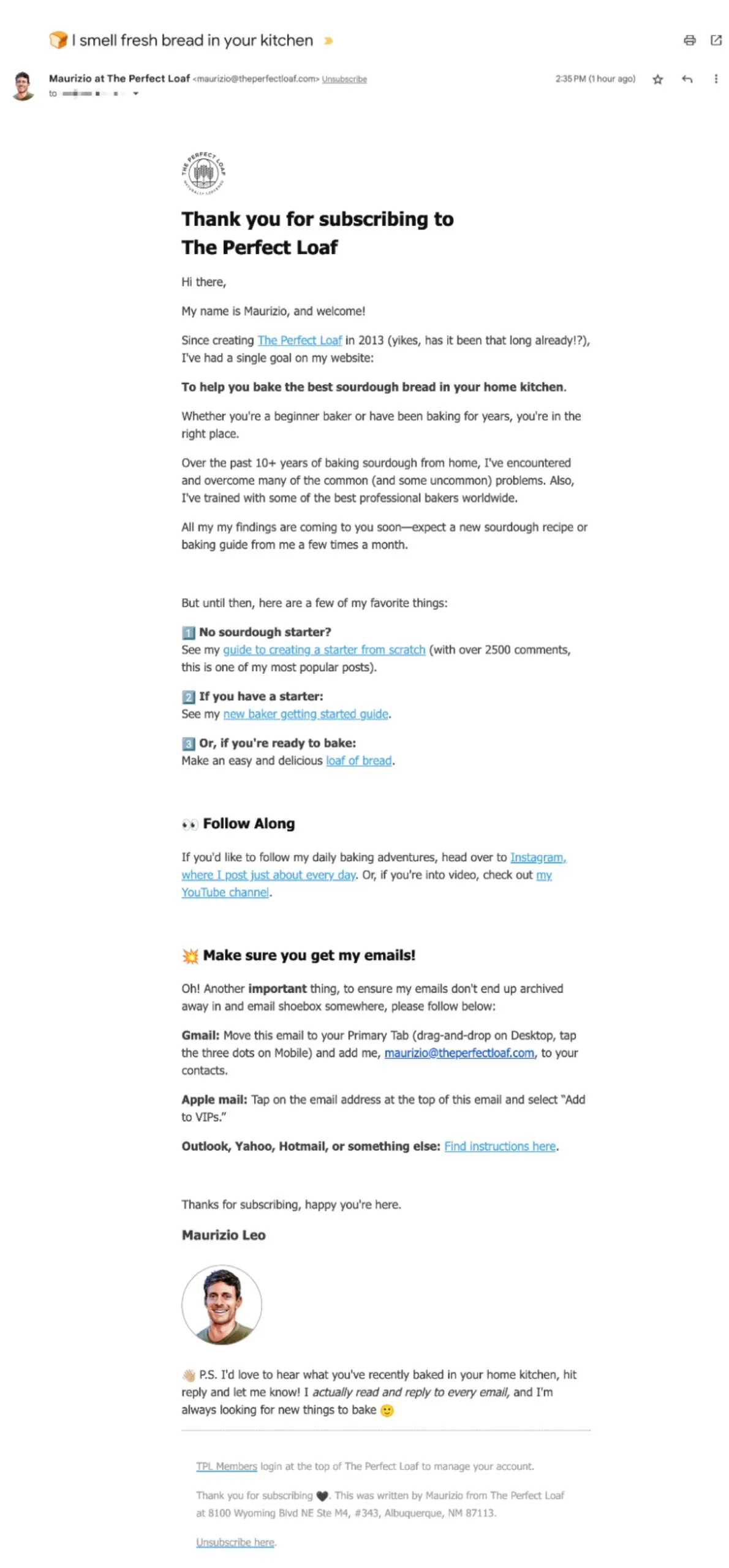
The Perfect Loaf welcome email
Welcome email subject line: 🍞 I smell fresh bread in your kitchen
Short, witty, and easy to stand out. The bread-making niche is a narrow one, so the bread emoji is a clever choice to emphasize its focus and drive the point home (without even having to read the words around it).
Welcome email structure:
- A welcome note
- An introduction to what the blog and newsletter are about
- Three links to popular, actionable guides
- Links to social media channels and YouTube
- A prompt to Maurizio as a safe sender
- A prompt to reply to the welcome email
Check out how Maurizio gained 598 subscribers in one month with Kit Network.
Write your welcome email series with our steal-worthy templates
Excited to write your own welcome email? We have a full kit of templates for welcome email subject lines, body copy, and a three-part welcome email sequence to kickstart your writing process.
Grab the welcome template you like most, fill in the blanks, and adjust it to your own writing style, tone, content, and audience.
P.S. Kit users can access any of the email templates in our library and easily convert them into welcome emails! Check them out in our newsletter design guide.
Welcome email subject line templates
Grab a subject line template that matches what your welcome email is about:
- Welcome to [newsletter name]!
- Welcome! A quick question for you
- What brought you to [newsletter name]?
- You’re subscribed to [newsletter name], [First name]
- [Freebie name]: Let’s do this!
- Thanks for signing up to [newsletter name]!
- Your [newsletter name] journey starts here
- You’re in! Here’s what’s next
- Hey [name]. Grab your [freebie name]!
If you want to send more than one email to welcome new subscribers, your next emails can be focused around subject lines like:
- More resources to help you with [goal]
- The story of [newsletter name] and what it means for you
- Let’s dive deeper into [topic]
- How these [audience type] succeeded thanks to [newsletter name]
A good subject line for your welcome emails will make it stand out from all the other emails your new subscriber receives that day. It reassures them they’re in the right place and nudges them to open it so they can learn what’s next and get to know your content and mission better.
Welcome email body templates
You can swipe any of the templates below to get started, but you can also consider the architect’s approach to writing your welcome email.
Remember the list of welcome email building blocks from our introduction to examples? Go back to that list and pick the blocks that resonate with you.
Do you want to drive new eyes to your most popular content? Get to know your subscribers better? Share your core philosophy? Mix and match the perfect blocks for your welcome email and other emails in your welcome sequence.
Template for welcome email #1: backstory, expectations, and survey
Hey [subscriber name],
Thanks so much for joining the [newsletter name] newsletter! I’ll be in your inbox [frequency; e.g. every Friday, twice a month] with tips on [topics].
[Topic] has a special place in my heart. [Add 2-3 sentences about your backstory and how you got to this place.]
With this newsletter, I want to help you [describe the outcome]. Every [frequency; e.g. Friday, week, month], I’ll send you [briefly describe the content of your newsletter; e.g. hand-picked links on a topic, my best tips, etc.].
While you wait for the next edition of the newsletter, hit ‘Reply’ and let me know:
Why did you subscribe to my newsletter? What do you hope to learn?
I read and reply to every email, and I can’t wait to hear from you.
Thank you again, and welcome! I’ll be back in your inbox in a couple of days with some links and tips you’ll love about [topic].
[Your name]
P.S. Be sure to add [your email address] to the safe sender list—it helps make sure my emails don’t end up in Spam or Promotions!
Template for welcome email #2: your best content
Hey [subscriber name],
As promised, I’m back in your inbox with some of the most impactful pieces the [newsletter name] content has made over the years:
- Link 1 [to a blog post, podcast episode etc.]: [a 1-2 sentence summary of the piece]
- Link 2 [to a blog post, podcast episode etc.]: [a 1-2 sentence summary of the piece]
- Link 3 [to a blog post, podcast episode etc.]: [a 1-2 sentence summary of the piece]
- Link 4 [to a blog post, podcast episode etc.]: [a 1-2 sentence summary of the piece]
Here’s what one subscriber shared about [newsletter name] content recently:
[Insert a screenshot of an email or a message from a subscriber, or embed a tweet, that showcases the impact of this content and builds your credibility]
My goal is to help you achieve [goal], and these links will give you a head start—I promise.
Which piece resonates with you the most? Hit ‘reply’ and let me know. I’ll wrap up this welcome sequence in a couple of days, when I’ll share with you a bonus resource that isn’t available anywhere else.
Talk soon,
[Your name]
Template for welcome email #3: surprise resource
Hey [subscriber name],
To wrap up this introduction to [newsletter name], I wanted to share something special with you: [describe a unique resource you haven’t made available elsewhere, like a guide, a PDF, a workbook, a video etc.].
Here’s a link to grab your own copy! It will help you [achieve a specific goal]—I can’t wait for you to try it out. When you do, hit ‘reply’ to let me know what you think.
I hope these welcome emails and resources have equipped you to work on [that goal]. You’ll receive the next regular newsletter edition on [day of the week], and then [email frequency, e.g. every Tuesday] thereafter.
Want to catch up in other places in the meantime? Check out my:
- Blog for [type of content]
- Instagram for [type of content]
- YouTube for [type of content]
- [list all relevant platforms and the type of content you post there]
Can’t wait to see you there! Until next time,
[Your name]
Best practices to make the experience even more welcoming
With welcome email examples and templates at your disposal, here are some tips to take away and make your welcome emails excellent.
1. Create a consistent experience
If you’ve implemented different ways people can sign up for your email list, like a dedicated newsletter landing page and an opt-in form on your website, consider creating different welcome emails for these different entry points.
Let’s take a cooking blog example:
If someone joined the list through a generic opt-in form on the website, the welcome email could introduce the creator, the 12 different recipe categories on the blog, and links to the most popular recipe from each.
But if a new subscriber joined by downloading a slow cooker guide, the welcome message can instead focus on how a slow cooker can benefit a busy household and share links to five easy slow cooker recipes.
Remember to keep your design, tone, formatting, and writing style consistent between your landing pages, welcome emails, and the emails that follow. That’s what will help your subscribers recognize your content wherever they run into it.
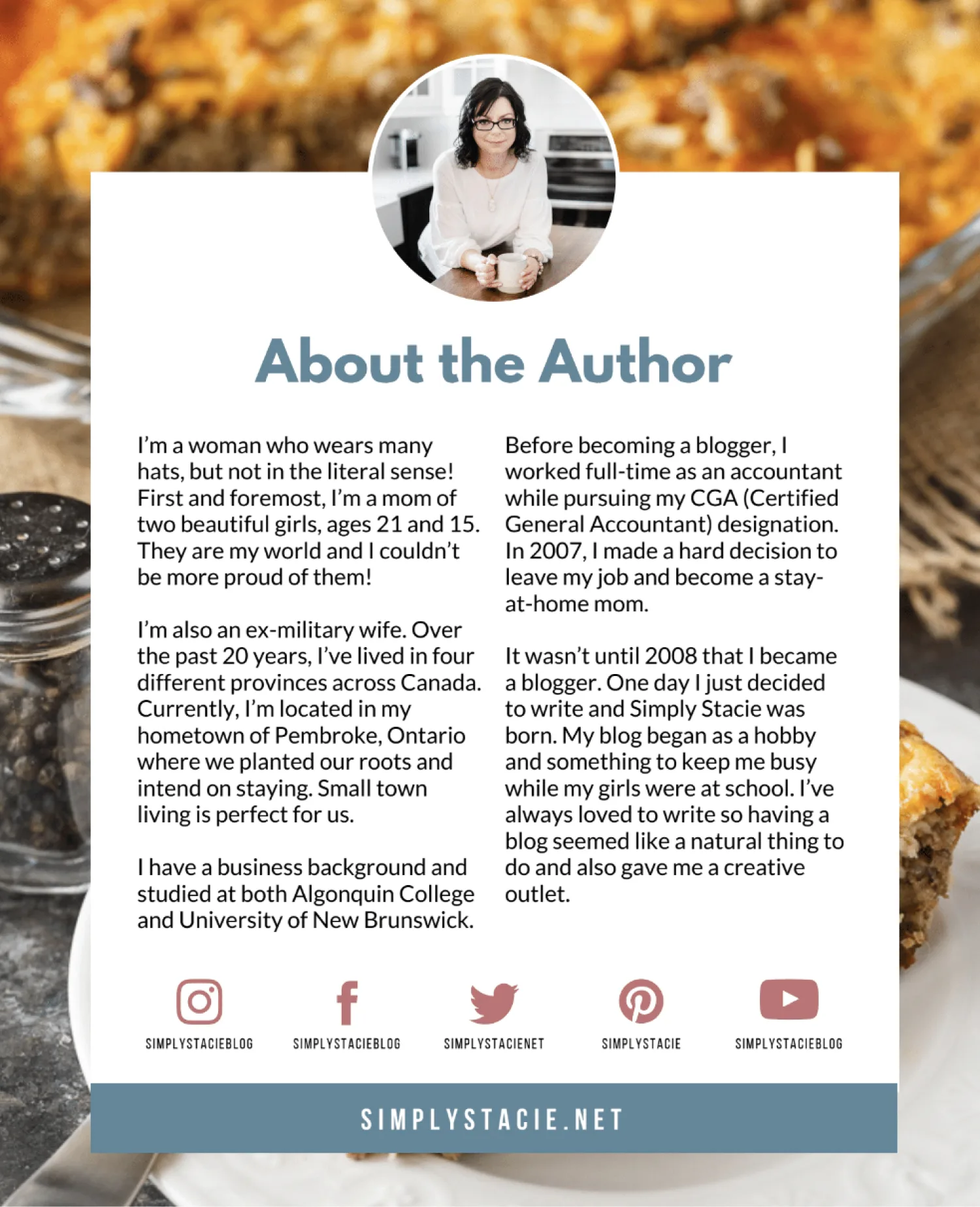
Remember Simply Stacie’s welcome email from earlier? The freebie she sends in it perfectly matches its look and feel
2. Less promotion, more value
Your welcome email should have the “Hello, new friend!” feeling rather than the “I’m about to overwhelm you with promotional, salesy emails” one.
This mostly comes from your writing style, email design, and even things like emojis. Plus, your welcome email is the ideal place to remind your new subscribers what you can do for them—not the other way around. Emphasize the value they can get by sticking with you.
Write your welcome email as if you’re writing a personal note to a friend, not a highly branded marketing email. Because even though you’re sending your email to dozens, hundreds, or thousands
of people, you’re actually writing to one. Make sure it feels like it.
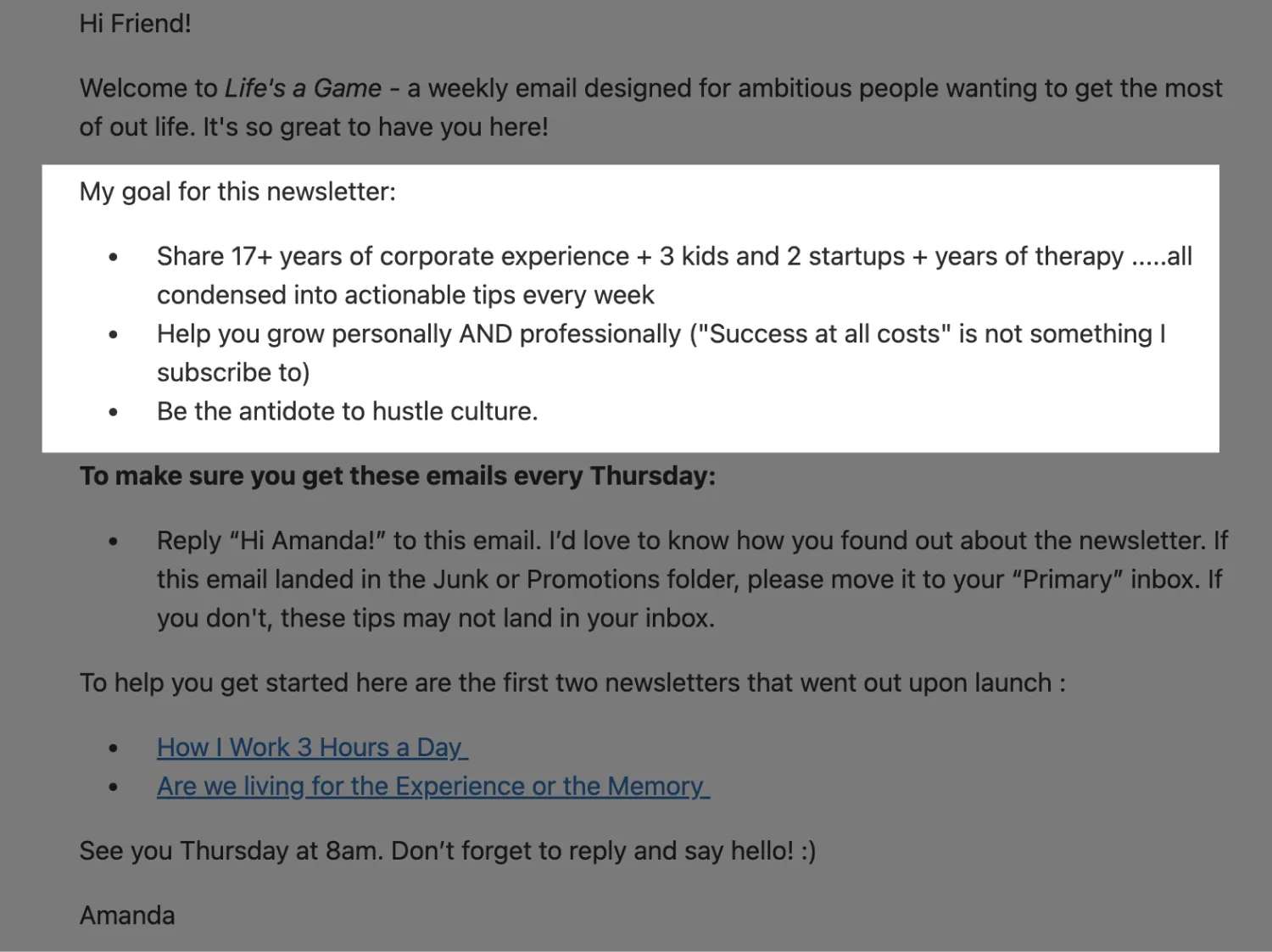
Amanda Goetz goes for a personal tone and a value-first approach in her welcome email
3. Personalize your (welcome) emails
It’s easy to see why personalized messages—those that reach the right person at the right time—tend to see higher open rates, engagement, and sales.
When it comes to an email marketing strategy, personalization is what deepens your connection with subscribers because it makes your email feel like you’ve only written it for them, not your entire email list.
To use personalized emails as a creator, consider strategies like:
- Adding your subscriber’s name to the subject line, greeting, and/or other spots in the welcome email
- Defining the next email they get from your email sequence based on what they clicked on in the previous one
- Tweak parts of an email based on criteria like location, industry, goal, or any other custom field you define
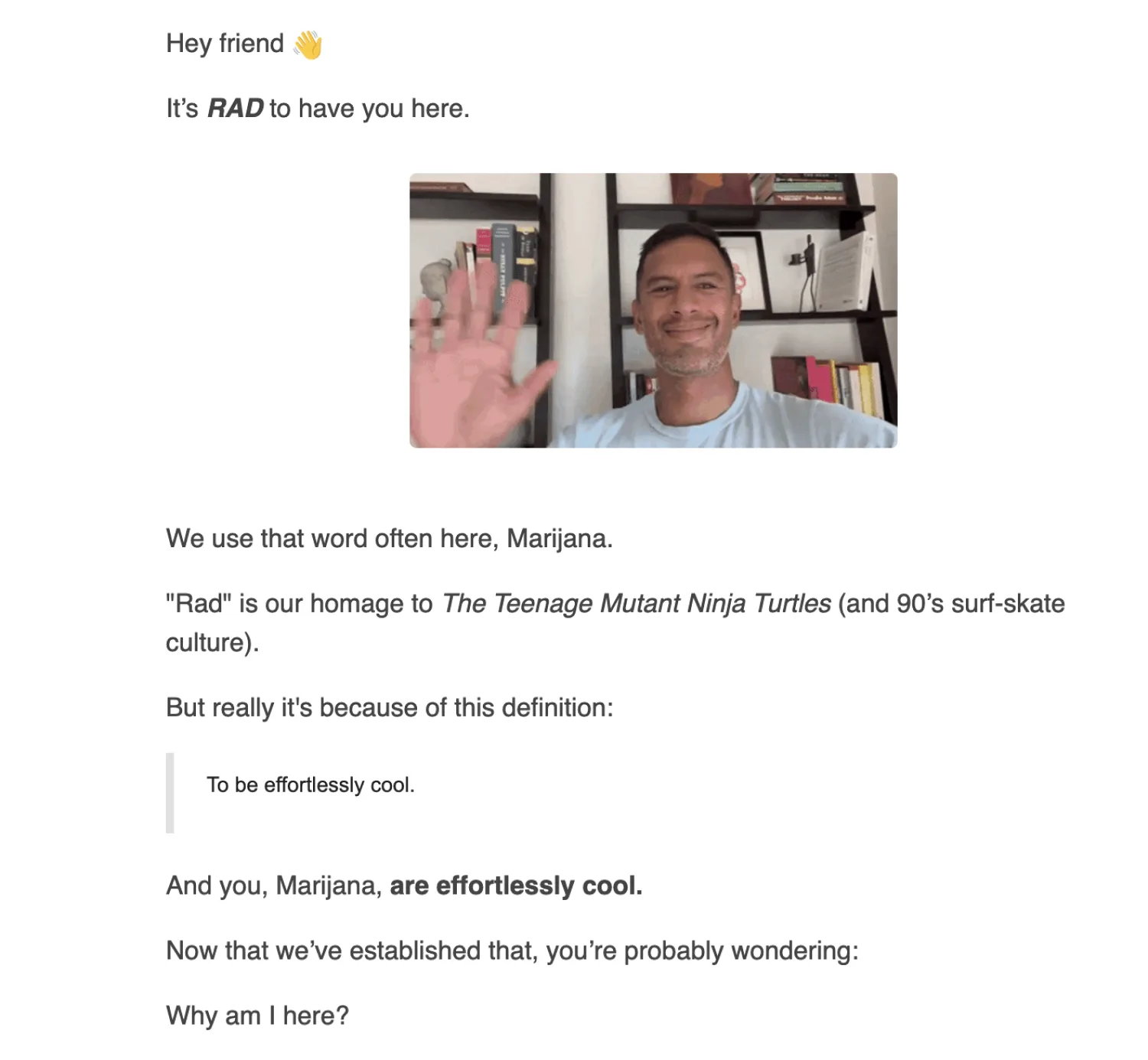
Khe Hy of RadReads references new subscribers by name multiple times in his welcome email
4. The best time to send your (first) welcome email: immediately
Think you should leave some time before you send that first email to a new subscriber? Think again.
The best time to send it is in the moment they’re the most excited about your content, which is right after they’ve signed up.
Chances are that as they’ve hit the ‘Subscribe’ button, they’ve jumped into their inbox to wait for your email, especially if your thank you note for subscribing encouraged them to head there to confirm their subscription.
If they need to wait for longer than a minute or two, they might close their inbox and not see your email for a while—hours or even days—when their excitement will likely deflate, and your welcome email won’t have the same effect.
Avoid that by automating your welcome email to go out instantly with a feature like Kit’s automations:
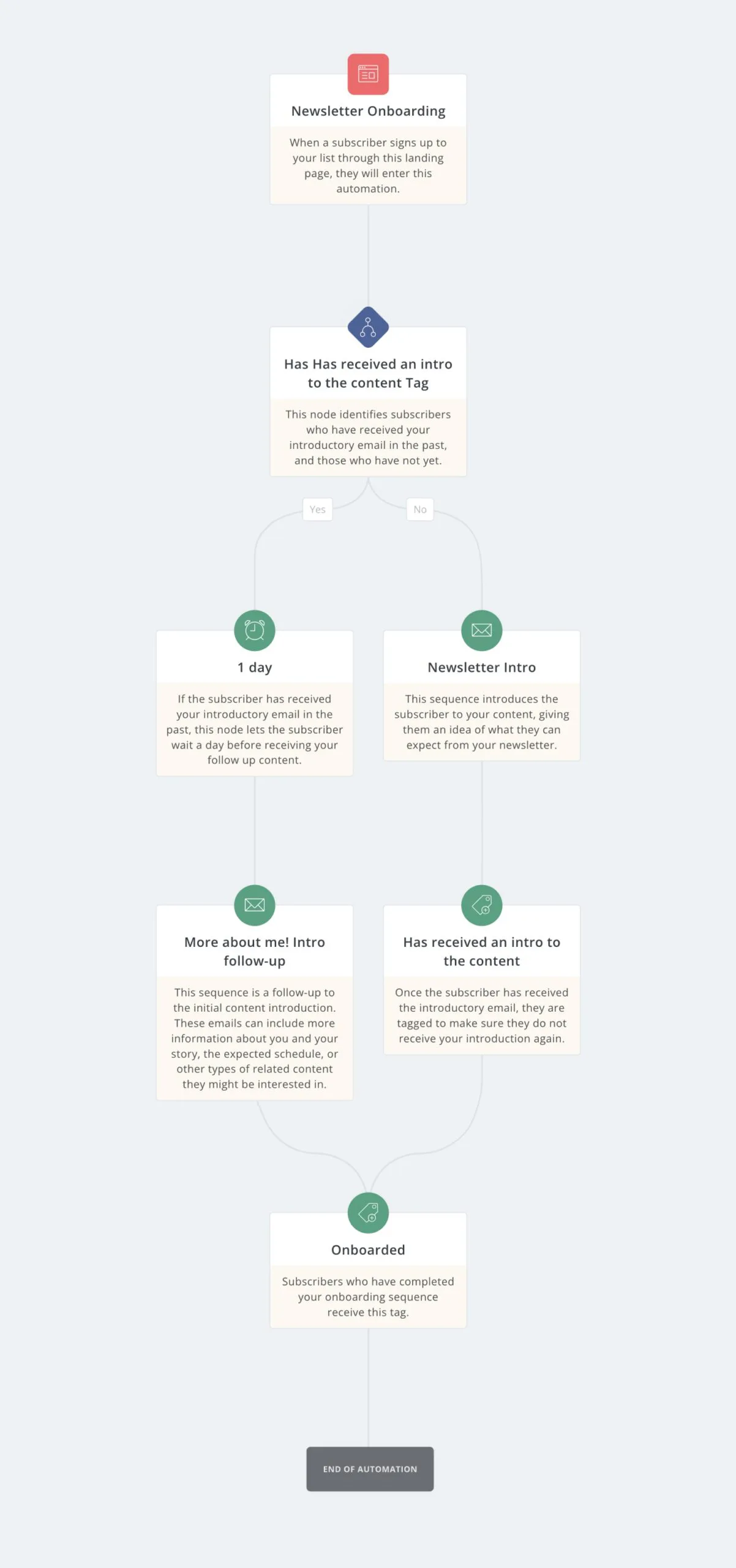
5. The ideal amount of emails in a welcome series
There isn’t one perfect number of emails to use in your efforts to welcome new subscribers. Some creators fit everything they want to convey into one welcome email—you’ve seen many of these in our examples earlier. Others spread it out over several emails and days, going into greater depth on topics they care about.
If you want to try using a welcome sequence, try some of these frequencies:
- Three emails over five days: two days between each email
- Three emails over a week: three days between each email
- Four emails over a week: two days between each email
- Five emails over five days: a daily email
The best approach you can take is one of a scientist—run experiments and track their impact through metrics like open rates, click rates, and the number of replies you receive. It’s another thing automations make super easy to create and test.

Tiago Forte’s welcome email sequence with five emails
6. End with an encouraging call-to-action
The best way to make the most of that excitement your subscribers feel for joining your list? Giving them a specific action to take from your welcome email.
That specific action is entirely up to you, and if you send multiple emails as a welcome sequence, you can have different call-to-actions in each of them. Some examples include:
- Replying to your email
- Following you on a platform like Instagram or YouTube
- Replying to your email
- Watching a specific video
- Subscribing to your podcast
- Reading a specific blog post
- Checking out your digital product
Direct your subscribers towards a path that will create more value for them and further establish you as someone they can trust when it comes to the topics you cover.
Automate your welcome email campaign with Kit
You have the examples to inspire you, the copy/paste templates, and the best practices to help you stand out with your welcome emails and sequences.
The last step is to jump into your email marketing tool and put this all into practice with smart, powerful automations. Don’t have it yet? Grab a Kit account made for creators just like you and explore what you can do for your audience.
![10 welcome email examples that instantly win over new subscribers [+ free-to-use templates]](https://media.kit.com/post/HERO-welcome-email-examples.jpg?fm=webp&q=50&auto=format)

